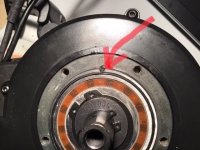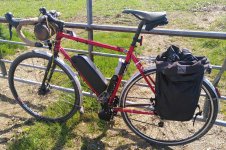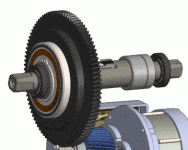For those following along in my tsdz2 install saga... I've been communicating with David from Eco-ebike. He's been very helpful in helping me QA/QC the issues and is helping to give input on the thermal capacity mod solutions.
In order to keep checking things off the list that could be issues... I did my same 6.3 mi / 165' elevation gain, commute to work today that I had a few times before. Ambient temps are more or less the same, maybe a handful of degrees warmer. Last time I did this ride I was experiencing overheating issues at 3.72 miles when riding at assist level 6. During that ride, my cadence was keeping the motor at more or less ~500rpm indicated, (which I read as 5,000 rpm) and many times, would end up above that for extended runs (3-5 minutes straight).
Today I tried the same ride, but kept the assist level in 4, and made sure to slow my cadence down to keep the motor at around 400 rpm indicated (again, I assume this is 4k rpm). Motor power seemed to hover around 100-150w for the most part. Average speed on this ride was down by 1.5mph overall, and max was down by 1mph as well. However, temps were never an issue and they stayed around 135-140 degrees for pretty much the entire ride. The motor casing was warm to the touch but not hot.
This is obviously a pretty huge improvement and it points to my high cadence being the problem. With the motor in it's current config, It will start to gradually heat up if I run it at 200w nominal and a cadence that keeps the motor rpm ~ 4,000rpm. However it's not like an out of control diesel engine where it just keeps getting hotter and hotter, even with the assist level at 1/2. It seems that the driver for the heat up truly is the cadence, combined with an assist level that keeps the motor around 200-250w. At the end of my ride this morning, I turned the assist level up, but kept my cadence slow and it does seem to heat up much slower then it was previously with a low assist level and a higher cadence.
So... I think part of the problem has been remedied in that, I just need to spin the bike slower when I'm on this e-bike. Overall, that's fine because I'm comfortable at a wide range of cadences being a mountain biker. I'm going to do a few more rides and then take the motor apart to do the temperature mods. Hopefully, it's just a matter of slowing things down...
Question: If I disable Field Weakening will that put the motor back in it's oem 90rpm cadence limit? If so, what is the effective max RPM that the motor is cutting out at so I can get an idea of what sort of gearing/cadence that would leave me with?*
*Sorry if the motor rpm, information is some where and I missed it. I've seen plenty in this thread about the cadence, but I don't quite remember (or I have never seen them) the gearing conversions as to what motor rpm that equates to.







